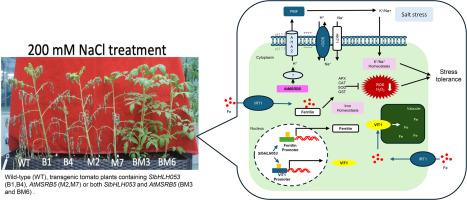SlbHLH053 and AtMSRB5 synergistically enhance salt tolerance in transgenic tomatoes
IF 6.8
Q1 PLANT SCIENCES
引用次数: 0
Abstract
Salt stress significantly affects crop yield. In this study, we found that co-expressing SlbHLH053 and AtMSRB5 can enhance salt tolerance in tomato plants. Our results indicated that the simultaneous expression of these genes improved tolerance to higher salt concentrations in transgenic tomatoes. We showed that SlbHLH053 is localized in the nucleus and can form homodimers, suggesting its role as a transcription factor. Furthermore, SlbHLH053 was able to bind to E-box elements and transactivate the SlCI7 promoter in vitro. Additionally, SlbHLH053 was found to have a role in salt and iron deficiency stress response, and in regulating iron homeostasis and antioxidant pathways. AtMSRB5 was verified to be important in maintaining ion balance and enhancing salt tolerance in transgenic tomato plants. The combination of both SlbHLH053 and AtMSRB5 led to an even greater tolerance to salt stress than either gene alone. The transgenic plants also exhibited improved ion homeostasis, with reduced sodium and elevated potassium levels under salt stress. The overexpression of SlbHLH053 and AtMSRB5 led to higher iron content and increased activity of antioxidant enzymes, such as ascorbate peroxidase and catalase, which are crucial for combating oxidative stress. These results also indicated that SlbHLH053 and AtMSRB5 mediate different antioxidant pathways to contribute to enhanced salt tolerance in transgenic tomato plants. In conclusion, the co-expression of the two genes in this study demonstrates a multifaceted approach to enhancing salt stress tolerance that may provide significant advantages for developing resilient crops in challenging environments.

SlbHLH053和AtMSRB5协同增强转基因番茄的耐盐性
盐胁迫对作物产量影响显著。在本研究中,我们发现SlbHLH053和AtMSRB5共表达可以增强番茄植株的耐盐性。我们的研究结果表明,这些基因的同时表达提高了转基因番茄对高盐浓度的耐受性。我们发现SlbHLH053定位于细胞核并能形成同型二聚体,提示其作为转录因子的作用。此外,SlbHLH053能够结合E-box元件并在体外反激活SlCI7启动子。此外,SlbHLH053被发现在盐和铁缺乏胁迫反应中发挥作用,并调节铁稳态和抗氧化途径。AtMSRB5在维持离子平衡和增强番茄耐盐性方面具有重要作用。SlbHLH053和AtMSRB5的组合比单独的任何一个基因都更能耐受盐胁迫。转基因植株在盐胁迫下也表现出改善的离子稳态,钠含量降低,钾含量升高。SlbHLH053和AtMSRB5的过表达导致铁含量增加,抗氧化酶活性增加,如抗坏血酸过氧化物酶和过氧化氢酶,这是对抗氧化应激的关键。这些结果也表明,SlbHLH053和AtMSRB5介导了不同的抗氧化途径,有助于提高转基因番茄的耐盐性。总之,本研究中这两个基因的共表达表明了一种多方面的方法来增强盐胁迫耐受性,这可能为在具有挑战性的环境中培育抗逆性作物提供显著的优势。
本文章由计算机程序翻译,如有差异,请以英文原文为准。
求助全文
约1分钟内获得全文
求助全文
来源期刊

Plant Stress
PLANT SCIENCES-
CiteScore
5.20
自引率
8.00%
发文量
76
审稿时长
63 days
期刊介绍:
The journal Plant Stress deals with plant (or other photoautotrophs, such as algae, cyanobacteria and lichens) responses to abiotic and biotic stress factors that can result in limited growth and productivity. Such responses can be analyzed and described at a physiological, biochemical and molecular level. Experimental approaches/technologies aiming to improve growth and productivity with a potential for downstream validation under stress conditions will also be considered. Both fundamental and applied research manuscripts are welcome, provided that clear mechanistic hypotheses are made and descriptive approaches are avoided. In addition, high-quality review articles will also be considered, provided they follow a critical approach and stimulate thought for future research avenues.
Plant Stress welcomes high-quality manuscripts related (but not limited) to interactions between plants and:
Lack of water (drought) and excess (flooding),
Salinity stress,
Elevated temperature and/or low temperature (chilling and freezing),
Hypoxia and/or anoxia,
Mineral nutrient excess and/or deficiency,
Heavy metals and/or metalloids,
Plant priming (chemical, biological, physiological, nanomaterial, biostimulant) approaches for improved stress protection,
Viral, phytoplasma, bacterial and fungal plant-pathogen interactions.
The journal welcomes basic and applied research articles, as well as review articles and short communications. All submitted manuscripts will be subject to a thorough peer-reviewing process.
 求助内容:
求助内容: 应助结果提醒方式:
应助结果提醒方式:


